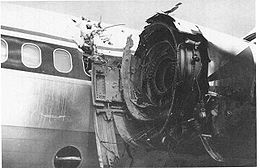- Delta Air Lines Flight 1288
-
Delta Air Lines Flight 1288 
Damaged Engine of N927DAAccident summary Date July 6, 1996 Type Uncontained engine failure Site Escambia County, near Pensacola, Florida, USA Passengers 137 Crew 5 Injuries 2 Fatalities 2 Survivors 135 Aircraft type McDonnell-Douglas MD-88 Operator Delta Air Lines Tail number N927DA Flight origin Pensacola Regional Airport Destination Hartsfield-Jackson Atlanta International Airport Delta Air Lines Flight 1288 was a regularly scheduled flight from Pensacola, Florida to Atlanta, Georgia on a McDonnell-Douglas MD-88 equipped with Pratt & Whitney JT8D-219 turbofan engines. During the flight's takeoff roll from runway 17 at Pensacola on July 6, 1996, the aircraft experienced an uncontained, catastrophic turbine engine failure that caused debris from the front compressor hub of the number one left engine to penetrate the left aft fuselage. The impact left two passengers dead and two severely injured. The pilot aborted takeoff and the airplane stopped on the runway. Three other passengers sustained minor injuries during the emergency evacuation. Most of the passengers were traveling on vacation.[1]
Contents
Pre-flight inspection
During the pre-flight inspection, the First Officer noted a few drops of oil coming from the "bullet" or tip of the number one (left) engine, although it was said to be "not that serious". The First Officer also noticed a couple of missing rivets on the left wing. The Pilot told NTSB investigators that both problems were observed as non threatening and that the aircraft was airworthy, therefore maintenance was not informed.[2]
Takeoff and Incident
At 2:23P CDT Delta Flight 1288 was cleared for takeoff on Runway 17. As the First Officer was advancing the throttles and reaching an airspeed of 40 knots, the cockpit lost lighting and instrumentation. The rear cabin passengers and flight crew heard a very loud bang and experienced a blast-like sensation. The pilot then abandoned takeoff by bringing the throttle to idle and engaging the brake which brought the aircraft to an eventual stop without use of reversers or spoilers.[2] Anita L. Saxton and 12 year-old Nolan Saxton sustained fatal injuries; 15 year-old Derek Saxton and 9 year-old Spencer Saxton were listed in "Good Condition" at Sacred Heart Hospital on July 7, 1996.[1]
Once the aircraft stopped the First Officer attempted to contact the tower, however was unable due to the cockpit's lack of power. The flight crew then activated emergency power contacting Pensacola tower and declaring an emergency. The cockpit's jump-seat passenger, an off-duty Delta Boeing 767 pilot, went to inspect the rear of the aircraft. When the First Officer saw the over-wing exits open and about half of the passengers missing along with engine noise, he returned to the cockpit and advised the captain to kill the engines. At 2:27P CDT the pilot requested emergency medical assistance due to the jump-seat passenger's report of a large hole in the fuselage, engine debris throughout the cabin, and injured passengers. He then reported there was no evidence of smoke or fire in the cabin, and that the rear cabin door had been opened and the emergency slide was inflated. The flight attendant who initiated the evacuation through that door told NTSB that she saw fire on the left engine therefore abandoned evacuation through that door and directed passengers forward. She reported that there were many injuries and possibly two dead, therefore she began to evacuate the plane until she was stopped by the First Officer. Due to the damage to and danger at the rear of the aircraft, the air stairs built into the MD-88 were found unsuitable to use. The captain then requested for portable air stairs to deplane passengers which arrived 25 minutes later.[2]
NTSB investigation
After a total investigation, the NTSB determined the most probable cause of the accident was a fracture in the left engine's front compressor fan hub, which resulted from failure of the airline's Fluorescent Penetrant inspection process to detect a potentially dangerous crack in the fan which originated from the engine's initial manufacture. The NTSB also attributed the accident to the failure of Delta's maintenance team to discover the problem.
Aftermath
As of September 2009 Flight 1288 no longer designates the Delta Pensacola-Atlanta (PNS-ATL) route. As of February 2010[update], the FAA reports the aircraft involved in the incident is still in service with Delta and still registered as N927DA.[3] As of October 2011[update], Delta continues to fly the MD88 and also uses the DC95 aircraft on its Pensacola-Atlanta route.
References
- ^ a b "2 die when engine shatters as jet takes off." Houston Chronicle. Sunday July 7, 1996. A1. Retrieved on February 13, 2009.
- ^ a b c NTSB Report of Delta 1288, NTSB, January 13, 1988.
- ^ FAA aircraft registry http://registry.faa.gov/aircraftinquiry/NNum_Results.aspx?NNumbertxt=N927DA
← 1995 · Aviation accidents and incidents in 1996 · 1997 → Aug 03 1995 – Aug 16 1996 Airstan incident
Jan 08 Air Africa crash
Feb 06 Birgenair Flight 301
Feb 29 Faucett Flight 251
Apr 03 USAF CT-43 crash
May 11 ValuJet Flight 592
Jun 09 Eastwind Airlines Flight 517Jun 13 Garuda Indonesia Flight 865
Jul 06 Delta Air Lines Flight 1288
Jul 15 Herculesramp
Jul 17 TWA Flight 800
Aug 19 Spair Airlines Flight PAR-3601
Aug 29 Vnukovo Airlines Flight 2801Oct 02 Aeroperú Flight 603
Oct 31 TAM Airlines TAR Flight 402
Nov 12 Charkhi Dadri mid-air collision
Nov 19 United Express Flight 5925
Nov 23 Ethiopian Airlines Flight 961
Dec 24 New Hampshire Learjet crashIncidents resulting in at least 50 deaths shown in italics. Deadliest incident shown in bold smallcaps.Categories:- Accidents and incidents on commercial airliners in Florida
- Aviation accidents and incidents in 1996
- Delta Air Lines accidents and incidents
- Accidents and incidents involving the McDonnell Douglas DC-9
- Escambia County, Florida
Wikimedia Foundation. 2010.


